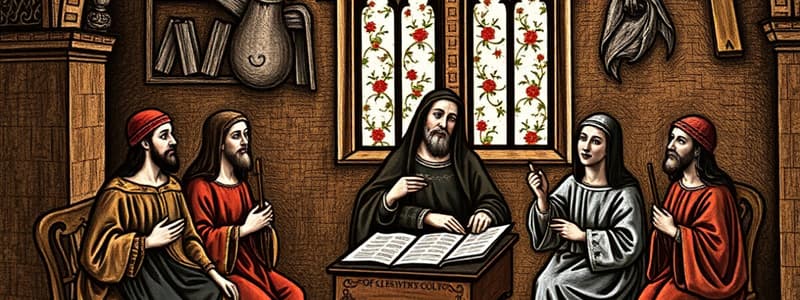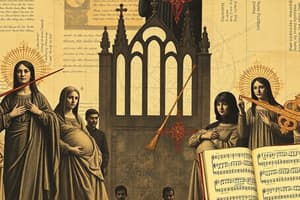Podcast
Questions and Answers
Which of the following is NOT a characteristic of Renaissance music?
Which of the following is NOT a characteristic of Renaissance music?
- Common use of monophony. (correct)
- Imitation among voices.
- Melodic lines moving in a flowing manner.
- Polyphony being the dominant texture.
What characterized the rise of secular music during the Renaissance period?
What characterized the rise of secular music during the Renaissance period?
- It replaced sacred music entirely.
- It became popular among the bourgeois class as entertainment. (correct)
- It was primarily composed for the church.
- It was mostly monophonic in style.
Which of the following sections is NOT part of the Mass music?
Which of the following sections is NOT part of the Mass music?
- Sonata (correct)
- Sanctus and Benedictus
- Agnus Dei
- Gloria
How is a Madrigal primarily characterized?
How is a Madrigal primarily characterized?
What is the primary focus of Mass music?
What is the primary focus of Mass music?
What is a defining characteristic of Gregorian Chant?
What is a defining characteristic of Gregorian Chant?
Which of the following best describes Troubadour music?
Which of the following best describes Troubadour music?
Who was Adam de la Halle?
Who was Adam de la Halle?
The Medieval Period is also referred to as the:
The Medieval Period is also referred to as the:
What was a primary influence on the culture and music of the Medieval Period?
What was a primary influence on the culture and music of the Medieval Period?
Which of the following was NOT a characteristic of Gregorian Chant?
Which of the following was NOT a characteristic of Gregorian Chant?
What does the term 'Renaissance' mean?
What does the term 'Renaissance' mean?
What themes were commonly explored in Troubadour music?
What themes were commonly explored in Troubadour music?
What is the main theme of a fugue called?
What is the main theme of a fugue called?
Which of the following compositions is NOT attributed to Johann Sebastian Bach?
Which of the following compositions is NOT attributed to Johann Sebastian Bach?
What characterizes an oratorio?
What characterizes an oratorio?
Which Baroque composer was known as 'il Prete Rosso'?
Which Baroque composer was known as 'il Prete Rosso'?
At what age did Johann Sebastian Bach demonstrate proficiency in violin?
At what age did Johann Sebastian Bach demonstrate proficiency in violin?
Which of the following works is attributed to Thomas Morley?
Which of the following works is attributed to Thomas Morley?
Who is known as the greatest Roman Catholic church musician of the Renaissance period?
Who is known as the greatest Roman Catholic church musician of the Renaissance period?
What is a defining characteristic of Baroque music?
What is a defining characteristic of Baroque music?
What does the term 'Concerto Grosso' refer to in Baroque music?
What does the term 'Concerto Grosso' refer to in Baroque music?
What was a common keyboard instrument used in Baroque music?
What was a common keyboard instrument used in Baroque music?
What does the Portuguese word 'Barroco' translate to in English?
What does the Portuguese word 'Barroco' translate to in English?
What type of musical texture is primarily found in Baroque music?
What type of musical texture is primarily found in Baroque music?
Which musical form was popularized during the Baroque period?
Which musical form was popularized during the Baroque period?
Flashcards are hidden until you start studying
Study Notes
Music of the Medieval Period (700 – 1400)
- Also known as the Middle Ages or "Dark Ages," beginning with the fall of the Roman Empire.
- The Christian Church played a crucial role in shaping European culture and politics.
- Sacred Music: Primarily monophonic plainchant, notably Gregorian Chant; originally transmitted orally, later notated for wider dissemination.
- Characteristics of Gregorian Chant include monophony, free meter, modal structure, usage in Latin liturgy, and neume notation.
- Secular Music: Composed for non-religious purposes, often performed by troubadours who sang about chivalry and courtly love.
- Troubadour music is typically monophonic and sometimes features improvised accompaniment, originating in France and written in French.
- Famous Composer: Adam de la Halle (1237 - 1288), known for secular compositions and connections to patrons like Robert II and Charles of Anjou.
Music of the Renaissance Period (1400 – 1600)
- The term "Renaissance" means rebirth, reflecting a revival of classical Greek and Roman ideals.
- Marked by the emergence of a bourgeois class, leading to the popularization of music as entertainment.
- The lute became the prominent instrument of the era, with declining influence of the Roman Catholic Church alongside the rise of secular music.
- Characteristics of Renaissance Music: Largely polyphonic, common imitation among voices, use of word painting, flowing melodic lines that are easy to perform.
- Vocal Music of the Renaissance: Includes Mass music, characterized by polyphony and various text settings (syllabic, neumatic, melismatic). Key sections are Kyrie, Gloria, Credo, Sanctus/Benedictus, and Agnus Dei.
- Madrigal: A significant secular vocal polyphonic composition from Italy, often performed a cappella during social gatherings, featuring 3-6 voices.
- Famous Composers: Giovanni Pierluigi de Palestrina (1525–1594), renowned for sacred music and counter-reformation style, and Thomas Morley (1557–1602), a significant secular composer known for his madrigals.
Music of the Baroque Period (1685 - 1750)
- The term "Baroque" originates from the Portuguese word "Barroco," meaning a pearl with an irregular shape, reflecting the ornate style of the era.
- Characterized by elaborate ornamentation, major and minor tonality developments, and the emergence of new instrumental techniques.
- Characteristics of Baroque Music: Elaborate and ornamental melodies, contrast between loud and soft dynamics, primarily contrapuntal textures with some homophony, use of strings and continuo in orchestras, and notable keyboard instruments like the harpsichord and organ.
- New musical forms emerged, including binary, ternary, ground bass, and fugue.
- Genres: Concerto (solo instrument with orchestra), Concerto Grosso (small group of solo instruments with an orchestra), fugue (contrapuntal piece with imitative counterpoint), oratorio (large-scale composition based on religious themes), and chorale (harmonized hymn-like compositions).
- Famous Composers: Johann Sebastian Bach (1685–1750), known for works like Brandenburg Concertos, Mass in B minor, and Toccata in D minor; Antonio Vivaldi (1678–1741), famed for "The Four Seasons"; George Friedrich Handel (1685–1759), recognized for his oratorio "Samson" and the famous "Hallelujah."
Studying That Suits You
Use AI to generate personalized quizzes and flashcards to suit your learning preferences.




